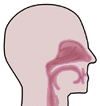  |
||
 |
April 2017Sonic hedgehog (Shh) in parotid saliva is a cell signaling moiety that acts on stem cells in taste buds to maintain normal taste functionTaste bud growth and development in animals has been inhibited by the absence of Shh with destruction of taste bud architecture. Replacement of Shh reverses this effect and restores normal taste bud architecture and taste function. Vismodegib, a drug used to treat basal cell carcinoma, caused diminution of Shh secretion and caused taste loss in these patients. Drugs which inhibited Shh secretion in animals also caused taste loss. Because of our interest in taste function these results led us to hypothesize that Shh, a known cell signaling moiety, would be present in parotid saliva, the biological fluid which supports taste bud growth and development, and that its decreased secretion would be associated with taste loss (hypogeusia). To test this hypothesis we evaluated if Shh were present in parotid saliva in 27 normal subjects and in 81 patients with hypogeusia related to several etiologies. Results demonstrated that Shh was present in parotid saliva of normal subjects and that Shh levels in patients with hypogeusia of all etiologies were significantly lower than in normal subjects. These results are consistent with Shh acting as a taste bud growth factor consistent with our previous results in which specific salivary moieties act on stem cells in taste buds to develop growth and perpetuation of taste bud receptors. Without salivary Shh, taste bud receptor development in humans is inhibited, as it is in animals. Without salivary Shh, taste buds exhibit apoptosis which destroys taste bud architecture similar to results in animals. This is the first demonstration of Shh in human saliva and is consistent with this signaling moiety acting as a taste bud growth factor which maintains normal taste function by stem cell receptor activation with subsequent growth and development of taste bud receptors. This information was presented at the Experimental Biology 2017 annual meeting in Chicago, IL, April 24, 2017. |
|